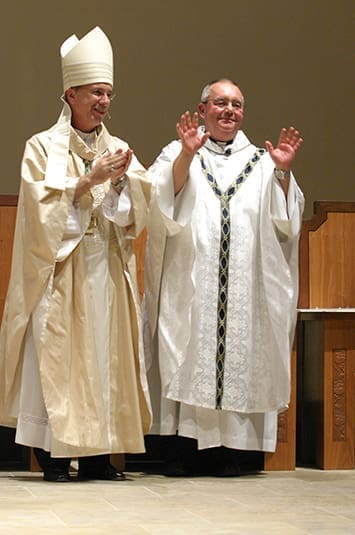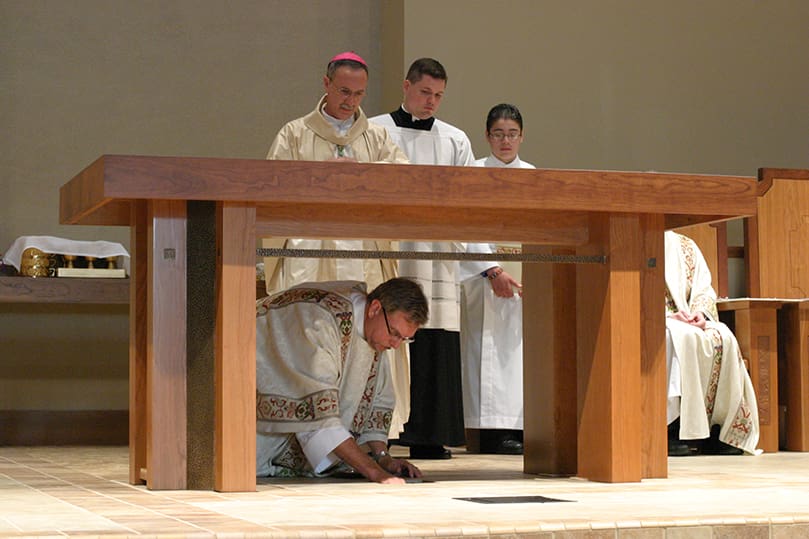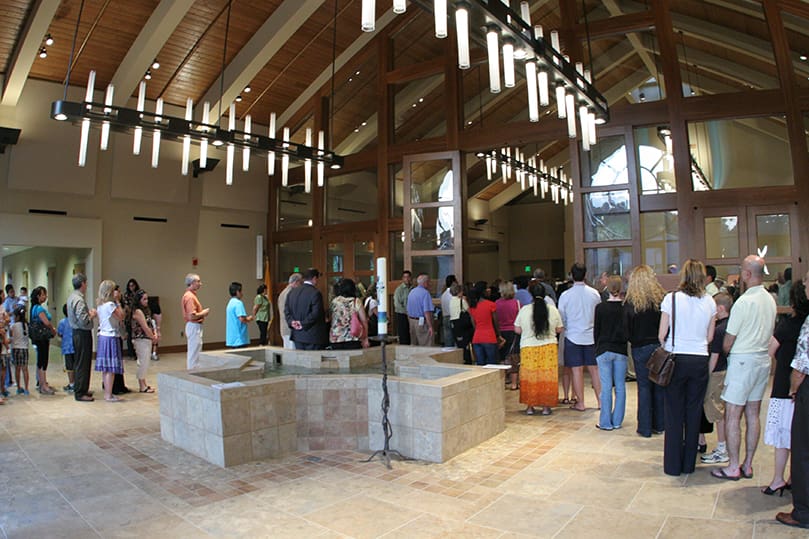With its natural granite facing, the new St. John Neumann Church, Lilburn, is some 36,000 square feet when you figure in the space for the upper and lower lever. The Gwinnett County church seats nearly 900 people. Photo By Michael Alexander
Lilburn
Lilburn Parishioners Rejoice In New Church
By STEPHEN O'KANE, Staff Writer | Published July 8, 2010
As the sun prepared to set on a warm summer evening June 24, hundreds of parishioners of St. John Neumann Church gathered outside awaiting the beginning of the Mass to dedicate their new church.
The opening song, “All Are Welcome,” seemed appropriate for the celebration as representatives from several countries and cultures were present for the Mass. The song also held a special meaning for those living with disabilities since the new SJN building includes creative and innovative ways to provide access to various parts of the church. This was an important facet for all of those involved in the project.
“The desire to make this new space fully accessible was central to us from the beginning,” Msgr. David Talley said.
Bishop Luis Zarama served as the main celebrant, with nearly a dozen priests present, including Msgr. James Fennessy, Msgr. Paul Reynolds, Father Walter Foley and Father Stewart Wilber, all former pastors of the Lilburn parish. The crowd parted, allowing the procession to approach the doors, where the architect, Deacon Terry Bigelow, presented Bishop Zarama with the plans for the church and the general contractor, Roger Huggins of Rogers Construction Co., provided the key.
Msgr. Talley, pastor, then received the key from the bishop and officially opened the doors.
After the crowd filed in, Bishop Zarama, along with the assisting deacons, took holy water from the large cross-shaped baptismal font in the narthex and passed through the church, blessing its walls and its people.
The Mass continued with readings in Spanish and English before Bishop Zarama addressed the crowd in both languages himself.

Bishop Luis Zarama, center stands before the altar during the Liturgy of the Eucharist along with (L-r) Deacon Mike Byrne, Father Bryan Small, master of ceremonies, and Deacon Gary Womack. The 10 foot cross made of cherry wood above the altar is the work of Marietta artist and Transfiguration Church parishioner Jorge Posada. Photo By Michael Alexander
“Congratulations, Monsignor, on a great job,” he said, a comment affirmed by a round of applause from the parishioners.
The bishop said that when Catholics celebrate Mass, they are united with the church in heaven. He commented on the physical beauty of the church but also reminded the community what truly makes the sanctuary special.
“What makes this (church) more beautiful are the living stones, each one of you,” Bishop Zarama said. “The living stones are the true treasures of this church. They show the presence of the Lord and show joy.”
Following the homily and the profession of faith, the relics of St. John Neumann, which were located in the altar and ambo in the old church, were deposited in the aperture under the new altar.
Bishop Zarama anointed the altar with sacred chrism, and clergy then took the chrism throughout the church to bless each of the walls. The bishop incensed the altar and then the church, with the assistance of the deacons. The candles were lit in the sanctuary for the first time, symbolizing that Christ is the light of the world.
Nearly 1,100 parishioners, friends and former parishioners were present at the Mass in the new church, which seats nearly double the amount of people of the former space. The old church was also filled with the overflow crowd who were able to watch a live broadcast of the Mass streaming on a large projection screen.
The natural, earthen look of the former sanctuary has been preserved in the new worship space. Several large clear windows are placed at the entrance, allowing copious amounts of natural light to flow through the building. Large stones surround the windows and cover the entire church, bringing a modern yet traditional look to the building.
The spacious narthex holds a large baptismal font, which is shaped like a cross. From the ceiling hang two strips of lighting, with each light cylindrical in form, resembling candles. The lights start at the baptismal font, where the Christian journey begins, and follow the path through the sanctuary up to the altar.
Above the altar hangs a life-size crucifix carved from cherry wood. The crucifix, produced by artist Jorge Posada of Marietta, features a dark cherry-stained corpus and a natural cherry-stained cross, matching well with the overall look of the sanctuary.
“At St. John Neumann the aesthetic foundation for the new worship space is unadorned beauty over ornateness,” wrote Dale Molnar, ecclesiastical artist for the project, in a letter to parishioners. “The objects crafted by area artists specifically for this sacred space capitalize on the inherent beauty and nobility in the natural attributes of the materials: wood, metal, stone clay.”
“Choosing local craftspersons for the artwork emphasizes the human touch as service to the sacred,” Molnar continued. “The result is a cohesive design that is true to church doctrine and that is neither austere nor pretentious or exaggerated.”
The Stations of the Cross, produced by Molnar’s son Thane, use the same cherry wood and bronzed elements found throughout the new church. The actual figures, which are made of clay, are large, detailed and expressive and can be recognized from nearly anywhere in the church.

Parishioners gather in their new worship space during the Mass of dedication at St. John Neumann Church, Lilburn. The small pattern of the ceramic tile floor going down the center aisle contrasts the larger, smooth tiles on both sides of it, so the visually impaired can know their whereabouts. The church includes a number of other features to meet the needs of the physically disabled. Photo By Michael Alexander
Eight stained glass windows positioned on each side of the nave provide a prayerful tone in the gathering space. These windows depict biblical stories and images, including the woman at the well, the prodigal son and the wedding feast at Cana, among others.
An image of Our Lady of Guadalupe, complete with a votive rail, where parishioners can light candles for their prayer intentions, is on the right side of the sanctuary.
The most striking features of the new worship space, which cost an estimated $6.2 million, are those focused on accessibility. Msgr. Talley, who has worked with people with disabilities for more than 20 years, felt that providing a worship space accessible to all was of utmost importance.
“I’ve been privileged to work with those living with disabilities for the 21 years of service as a priest. By God’s grace, I have been a part of Toni’s Camp since 1989. But I was not alone in this. All the members of our sacred space team felt the same way,” said Msgr. Talley.
One of these features is the ambo, which can be lowered in height to accommodate all who serve as lectors or cantors, including children and those in wheelchairs. The sanctuary is accessible to all by way of a ramp. The altar itself can be lowered to accommodate priests, deacons or Eucharistic ministers in wheelchairs.
Confessionals have been designed with equipment for those with significant hearing loss and the tabernacle was positioned lower to the ground, allowing a person in a wheelchair to access the tabernacle and other cabinets for sacred vessels.
“The simple beauty of the new church of St. John Neumann is a lesson in a healthy ecclesiology … where all work for a common purpose and consensus is the desired outcome at every meeting (of every level) of the project,” said Msgr. Talley.

Bishop Zarama joins the congregation as they give their pastor Msgr. David Talley a long and rousing ovation at the conclusion of the Mass. Photo By Michael Alexander
“We wanted it to be a model for others,” said Dennis Kelly of Catholic Construction Services, who assisted with the project. He said the new church is the only one in the archdiocese to include all of these features under one roof.
The community at St. John Neumann, which now serves approximately 2,000 registered families and up to 500 unregistered families, has been very vocal about their approval of the new worship space.
Mona Fetta, a parishioner since 1994, fought back tears as she said she felt pride and joy for what the community has accomplished with the new church. To her, it brought a “sense of peace and accomplishment.” She also enjoyed seeing the former pastors present for the momentous occasion for the Lilburn church.
Keith Schuaner has been worshiping at the parish for nearly 12 years. He said the new church “will be a great opportunity for the whole parish to celebrate under one roof.”
At the end of the Mass, Msgr. Talley took time to thank all those who have been involved with the process, from the general contractor to the architect to everyone on the various committees who made it possible. Overall, he feels it has been a great success.
“Everyone has commented on the beauty of the church, its simplicity and its warmth,” said. Msgr. Talley. “We’ve been in this new space as a praying community for less than a week, and it already feels like home.”
“The feeling or mood in praying in the new church is one of joy,” he said. “When you’ve worked collaboratively to bring about the creation of a beautiful new worship space, you can’t look at any one facet of the space and not think about the work that went into its creation.”
Rebecca Wilson, student intern at The Georgia Bulletin, also contributed to this article.



